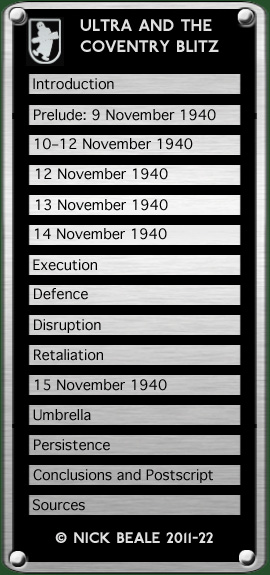|
[The Wireless Operator] tuned into Saint Malo and got a beacon in England. He didn’t realise. (Feldwebel Hans Lehmann, 2./KGr. 100) The RAF’s No. 80 Wing is perhaps best known for its pioneering efforts in ground-based electronic jamming and spoofing but its Wireless Intelligence Development Unit (under W/C Robert Blucke) also deployed the antecedents of the “Wild Weasel” aircraft used over North Vietnam by the USAAF a quarter-century later. WIDU’s contribution to Cold Water was “Douche”, an attack on Knickebein IV and the WESER and SPREE transmitters on the Cherbourg Peninsula. The inspiration for the operation may have been two happy accidents discovered through Ultra. At 02.00 GMT on 11 October, SPREE was reported “completely destroyed” by bombardment (during Operation Medium, a combined RAF/RN operation against invasion shipping in Cherbourg). Bletchley Park’s Commander M.G. Saunders noted that “AM [Air Minstry] and AY [Admiralty] know nothing about this”, so if either force’s action destroyed SPREE it was by accident, not design. The transmitter was out of action for a month, apparently owing to a shortage of replacement equipment, before resuming operations on 10 November. DONAU reported attacks on 12 and 14 October and was relocated on the 16th; bombs fell near ISAR (at Ambleteuse, about 10 km. north of Boulogne) on the 12th and 26th; on 2 November it was ELBE's turn. (See here for more details).
Bombs were not the only threat. On 18 October at 08.30 hours, two rounds of "enemy artillery fire" were reported landing 400 m. from ISAR. British heavy artillery emplaced around Dover did shell German cross-channel batteries in the Boulogne–Wissant area but all seem to have been some kilometres from ISAR so the beam station may have been the intended target. There was another alarm at the station at 08.00 on 26 October: aircraft were passing overhead and were being heavily engaged by Flak, while "artillery activity" had begun.
Reporting on 8 November, Group Captain E.B. Addison (OC No. 80 Wing) was dismissive of Knickebein, citing analysis of German bombing which “has so far failed to reveal any marked degree of accuracy either locating important targets or in aiming bombs at particular points.” What was more, prisoners had “frequently admitted failure to locate their bombing objectives”, all of which was taken as evidence that the Luftwaffe was not able fully to realise the potential of its navigational aids. The “river” beams were a different matter as it was becoming apparent that “the select few of KG 100” were attaining accuracies much greater than previously seen. Addison had a proposal: If we can effectively deny the use of this device to the enemy when it is being utilised by only a few, it is to be hoped its adoption on a larger scale will be prevented. At the same time he recognised that, compared to Knickebein, X-Gerät would present “a stiffer problem” to “our meagre ‘anti’ devices.” continued on next page …
|
|||||

